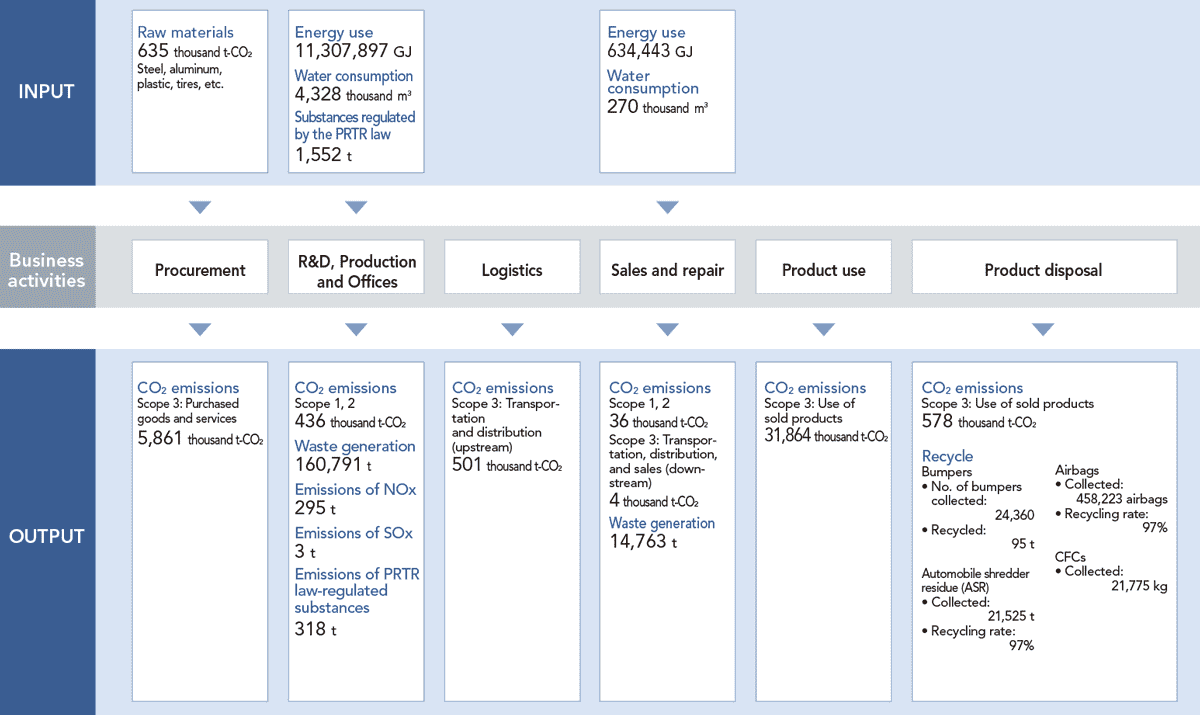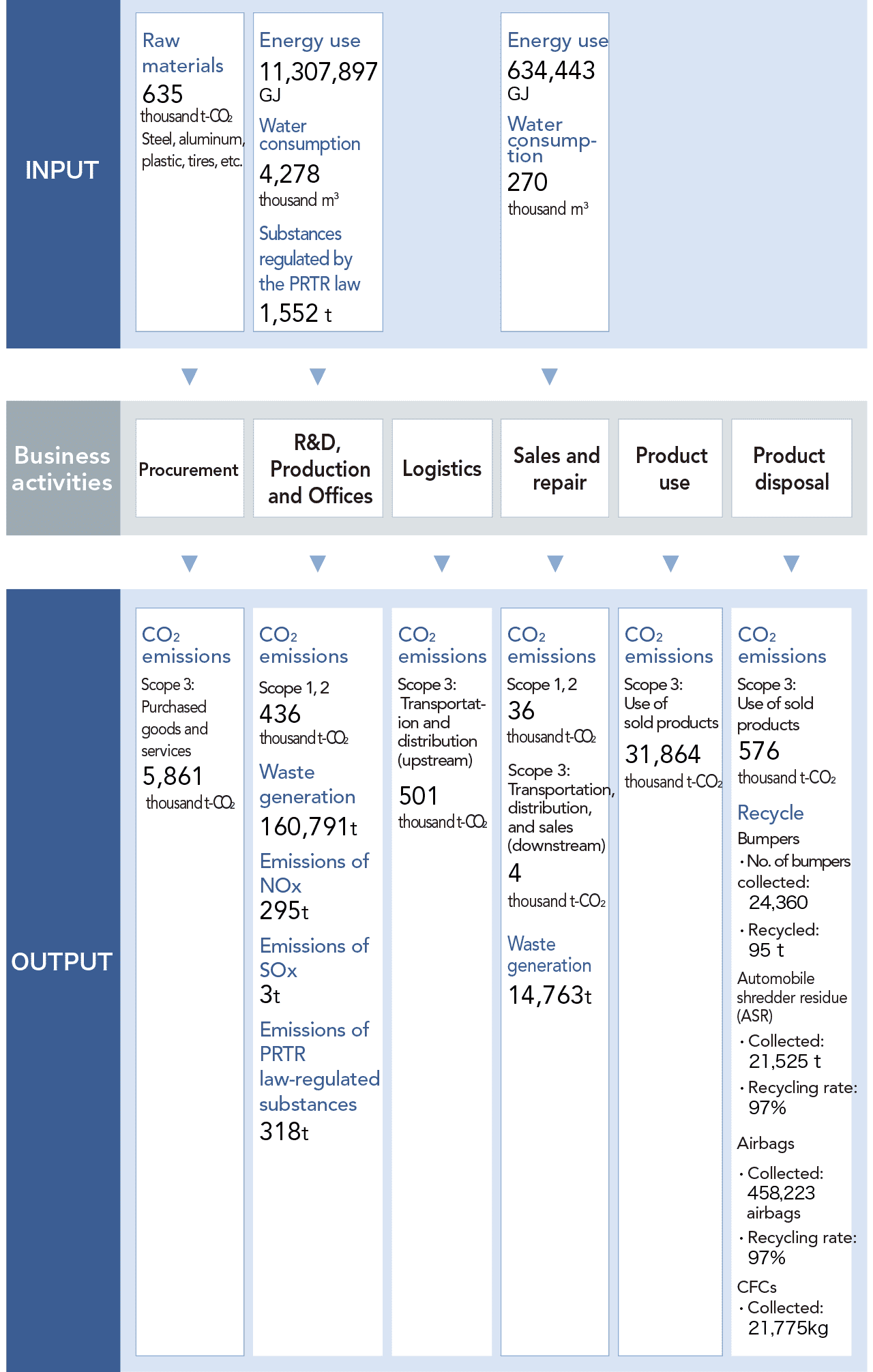Environmental Management
Our Approach
Vision and Roadmap
In its Environmental Policies, SUBARU states that our fields of business are “the earth, the sky and nature” and focuses on efforts aimed at coexistence with nature. Furthermore, the Group has defined the Environment as one of our Six Priority Areas for Sustainability, and considers activities for the environment as key to the continuation of our business.
The SUBARU Group has set its vision for the environment as “Cherish and protect the environment—the earth, the sky and nature—through Group-wide activities.” Within this, we have identified the three priority themes of mitigating climate change, realizing a circular economy, and coexistence with nature. By addressing these environmental issues, we aim to ultimately reduce the environmental impact on the natural world to virtually zero, and to go even further to make a positive impact.
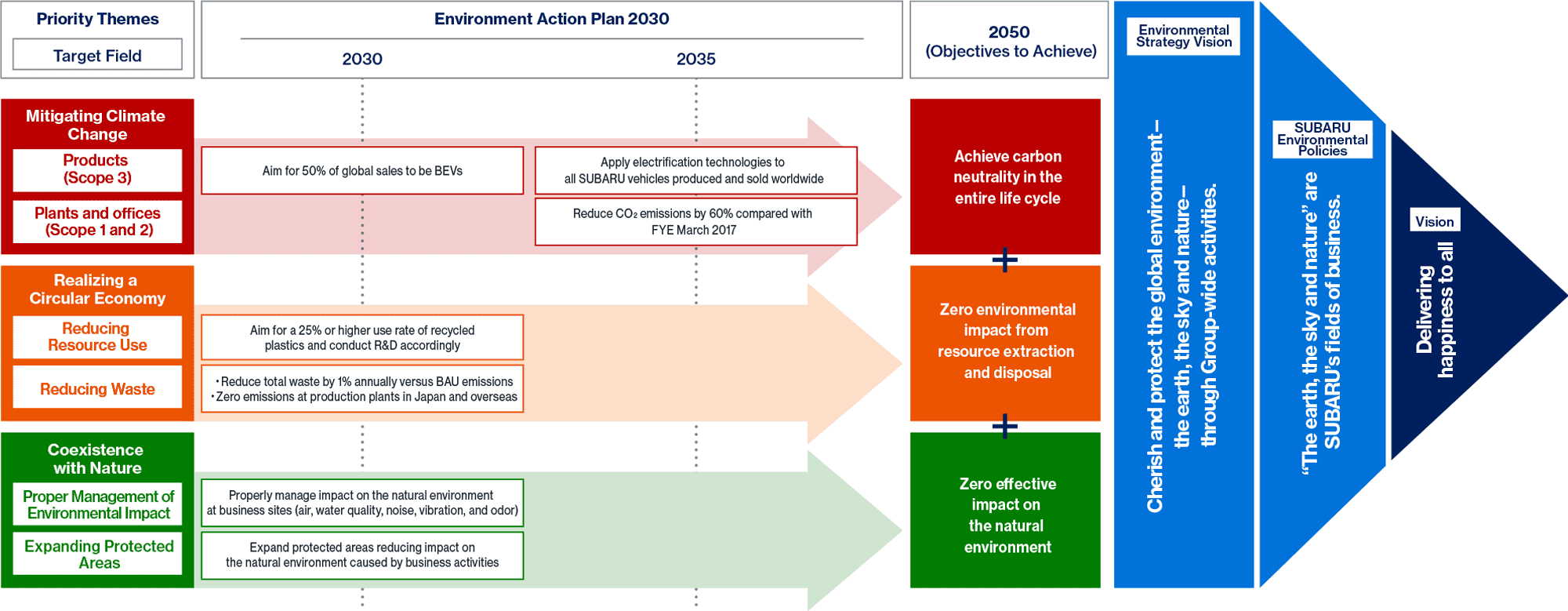
SUBARU Environmental Policies
SUBARU Environmental Philosophy
“The earth, the sky and nature” are SUBARU’s fields of business.
With the automotive and aerospace businesses as the pillars of SUBARU’s operations, our fields of business are the earth, the sky and nature.
Preservation of the ecosystem of our planet, the earth, the sky and nature, is of utmost importance to ensure the future sustainability of both society and SUBARU. We align our business strategy to enhance these global goals in all of our operations.
- We develop and deliver products to meet social needs and contribute to the environment through advanced technologies.
By striving to create advanced technologies that put the environment and safety first, we will develop and deliver products that can contribute to protecting the earth’s environment. - We focus on efforts aimed at coexistence with nature.
Together with efforts to reduce CO2 emissions in all of our operations, we will promote active engagement with nature by stressing forest conservation. - We take on challenges as one through an all-SUBARU approach.
Utilizing our unique organizational character that allows us to oversee the entire supply chain, all of us together will take on the challenges of environmental protection of our planet through an all-SUBARU approach.
Environmental Principles
SUBARU’s fields of business are the earth, the sky and nature. SUBARU understands that the health and preservation of biodiversity and controlling climate change are critical to ensuring a sustainable future for our planet earth, nature, communities, and businesses.
- Products:
- We develop our products and conduct R&D in light of the life cycle environmental impacts of our products.
- Procurement:
- Our procurement activities reflect consideration for biodiversity and other aspects of environmental protection.
- Production:
- We strive to minimize our environmental impact through improving energy efficiency and waste management.
- Logistics:
- We strive to minimize our environmental impact through enhancing energy efficiency and promoting pollution prevention.
- Sales:
- We endeavor to recycle resources efficiently and reduce waste.
- Management:
- We will strive to improve our sustainability program through contributions that meet social needs and by publicizing our activities as Team SUBARU.
Management System
Environmental Management System
SUBARU has established a cross-organizational environmental management system centered on two pillars, the Environment Committee and the environmental management system (EMS), to comprehensively manage the direction and progress of its environmental measures. Leveraging this structure, we promote various environmental management activities across the entire SUBARU Group, including formulating and implementing measures to achieve medium- to long-term environmental targets, ensuring compliance with environmental laws and regulations, and aggregating environmental performance data.
Environment Committee
SUBARU has established the Environment Committee, which discusses measures (e.g., targets) from broad and medium- to long-term perspectives that accommodate future environmental standards required by society, and evaluates the progress of related implementations and achievements. The Environment Committee is chaired by the Executive Officer in charge of the Sustainability Division appointed by the Board of Directors. Details of discussions by the Environment Committee are reported to the Sustainability Committee. Important matters are also brought to the attention of and reported to the Board of Directors, which oversees the Sustainability Committee.
In addition, four subcommittees have been created under the Environment Committee, with participation from major Group companies and comprising the SUBARU Group’s environmental management organization.
Furthermore, we cooperate with the Purchasing Committee, the Engineering Environment Committee, and overseas Group companies as necessary on relevant topics.

Environmental Management System
The SUBARU Group has established an environmental management system (EMS) covering its sites, Group companies in Japan and overseas, domestic dealerships, and business partners.
Five domestic consolidated subsidiaries, excluding SUBARU and Ichitan Co., Ltd., have obtained ISO 14001 group certification and operate an integrated EMS by sharing information through regular meetings and conducting mutual internal audits between secretariats.
In addition, three overseas consolidated subsidiaries, Subaru of Indiana Automotive, Inc., Subaru of America, Inc., and Subaru Canada, Inc. have obtained ISO 14001 certification, and Subaru of Indiana Automotive, Inc. obtained ISO 50001 certification, an international standard for energy management systems (EnMS), in 2012.
Furthermore, all 23 dealerships in the scope of consolidation and 10 dealerships outside the scope of consolidation in Japan have acquired Eco Action 21 certification. Under the certification system, they promote their EMS and carry out environmental audits on a regular basis for environmental conservation and compliance with environmental laws and regulations.
Compliance with the SUBARU Green Procurement Guidelines is also considered a necessary criterion for selecting business partners, and we request that they establish an EMS based on acquisition of third-party ISO 14001 certification.
| SUBARU domestic facilities | Domestic consolidated subsidiaries | Overseas consolidated subsidiaries | Dealerships | Business partners | ||
|---|---|---|---|---|---|---|
| Management system | ISO14001 | ISO14001 | ISO14001 | ISO50001*1 | Eco Action 21*2 | ISO 14001, Eco Action 21 or self-certification*3 |
| Target | Gunma Plant Tokyo Office Utsunomiya Plant Head Office |
Fuji Machinery Co., Ltd Kiryu Kogyo Co., Ltd. Yusoki Kogyo K.K Subaru Logistics Co., Ltd. FAS Corporation Ichitan Co., Ltd. |
Subaru of Indiana Automotive, Inc. Subaru of America, Inc. Subaru Canada, Inc. |
Subaru of Indiana Automotive, Inc. | Dealerships 33 companies in total |
Business Partners |
- *1
- International standard applicable to all organizations that sets the requirements to be met by business operators when conducting activities to build an energy management system, including the formulation of policies, targets, and plans for their energy use and the determination of management procedures
- *2
- Environmental conservation activity promotion program formulated by Japan’s Ministry of the Environment in which SMEs work on three themes: EMS, environmental measures, and environmental reporting
- *3
- Environmental management system based on self-certification, in which business partners are deemed to have passed if they answer “yes” or “not applicable” to 43 or more of the 47 items in the SUBARU-drafted voluntary assessment report based on our EMS, and answer “yes” to all three items related to legal compliance
Management of Chemical Substances
Internationally, there is a growing movement calling for the understanding, proper management and handling, and information disclosure of chemical substances contained in products.
To minimize the impact of chemical substances used by SUBARU in automobiles on people and to help preserve the environment through reduced impact, we use IMDS*1 as a method to manage our entire supply chain in order to identify which chemical substances are used in what amount in each of the several tens of thousands of parts that comprise our automobiles. Furthermore, we use SUBARU’s proprietary chemical substance management system to substitute and/or manage elimination of substances prohibited under laws and regulations such as the REACH regulation*2, the ELV Directive*3, the U.S. Toxic Substances Control Act, and Japan’s Act on the Evaluation of Chemical Substances and Regulation of Their Manufacture, etc., and to appropriately disclose information on controlled substances required by the WFD*4 and other regulations. This work to manage chemical substances also aids in the SUBARU Group’s work toward resource and other recycling.
SUBARU is also actively working to reduce environmentally hazardous substances in its vehicles, working in cooperation with its business partners from the design and development stages of its next-generation vehicles. We maintain achievement of the environmentally hazardous substance reduction targets for lead, mercury, hexavalent chromium, and cadmium set by Japan Automobile Manufacturers Association, Inc. (JAMA) for all new models released in and after 2008. Furthermore, in order to ensure compliance with chemical substance regulations enforced across the world, we are further reducing the use of lead and replacing environmentally hazardous substances such as flame retardants and UV absorbers that have been confirmed to be harmful.
- *1
- IMDS: International Material Data System, an international materials database for the automobile industry
- *2
- REACH (Registration, Evaluation, Authorisation and Restriction of Chemicals) Regulation: A European regulation requiring all chemical substances to be subject to management or restriction measures commensurate to the risk that they pose to humans and the environment
- *3
- ELV (End-of-Life Vehicles) Directive: A European automotive disposal directive requiring reduction of environmental impact from vehicles that are no longer used
- *4
- WFD (Waste Framework Directive): A European directive requiring waste control and management
International Material Data System
Management of Chemical Substances through the IMDS
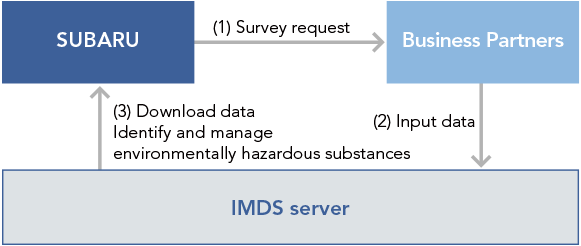
Targets and Results
Revision of the Environment Action Plan 2030
The SUBARU Group has revised its Environmental Action Plan 2030 to set three priority themes and corresponding objectives, and to establish medium-term goals for achieving them. The SUBARU Group aims to realize its vision to “Cherish and protect the global environment—the earth, the sky and nature—through Group-wide activities.” To this end, we will promote initiatives that will lead to the realization of our vision, focusing on actions set for our medium-term goals, with the ultimate goal of reducing our environmental impact on the natural world to zero, and to go on even further to make a positive impact.
| Priority Themes | Target Fields | Environment Action Plan 2030 |
|---|---|---|
| Mitigating Climate Change | Products (Scope 3) | By 2030, aim to make 50% of SUBARU global sales BEVs. |
| Apply electrification technologies*1 to all SUBARU vehicles*2 produced and sold by the early 2030s | ||
| Plants and offices (Scope 1 and 2) | Reduce CO2 emissions by 60% in FYE March 2036 compared with FYE March 2017 (total volume basis) | |
| Realizing a Circular Economy | Reducing Resource Use | Pursue research and development targeting the use of recycled materials*3 for more than 25% of the plastic used in new models |
| Reducing Waste | Reduce total amount of waste by 1% annually versus BAU*4 emissions | |
| Zero emissions*5 at production plants in Japan and overseas*6 (zero landfill waste either directly or indirectly) |
||
| Coexistence with Nature | Proper Management of Environmental Impact | Properly manage impact on the natural environment at business sites (air, water quality, noise, vibration, and odor) |
| Expanding Protected Areas | Expand protected areas reducing impact on the natural environment caused by business activities |
- *1
- Refers to the technology used to foster the use of electricity for EVs, HEVs, and others
- *2
- Excluding models that receive OEM supply from other companies
- *3
- Including material and chemical recycling
- *4
- Emissions under the current policy without further action (business-as-usual)
- *5
- Final disposal amount (total amount of direct landfill waste + landfill waste after intermediate processing) less than 0.5% of the total amount of waste (total amount of valuable resources + industrial waste + specially controlled industrial waste + general business-related waste)
- *6
- Parent company: Gunma Plant, Tokyo Office, Utsunomiya Plant; Subsidiaries: Fuji Machinery Co., Ltd., Kiryu Kogyo Co., Ltd., Ichitan Co., Ltd., Subaru Logistics Co., Ltd., Yusoki Kogyo K.K., Subaru of Indiana Automotive, Inc.
Key Initiatives related to the Environment Action Plan 2030
Here, we list the key initiatives related to the Environmental Action Plan 2030, which was in effect until FYE March 2025.
Climate Change
Ⅰ. Key Initiatives related to the Environment Action Plan 2030
| Field | Long-Term Goals | Environment Action Plan 2030 | |||||
|---|---|---|---|---|---|---|---|
| Medium-Term Goals (Primary Category) | Short-Term Initiatives (1–3 Years) | Major Results in FYE March 2025 | |||||
| Facilities | Goals by facility | Primary Initiatives | |||||
| Scope 1 and 2 (plants and offices) | Target carbon neutrality by FYE March 2051. | Reduce CO2 emissions by 60% in FYE March 2036 compared with FYE March 2017 (total volume basis) | Plants | Reduce CO2 emissions from plants in Japan. | Reduce CO2 emissions by 60% in FYE March 2036 compared with FYE March 2017 (total volume basis) |
|
|
|
|
||||||
| Reduce CO2 emissions from plants overseas. |
|
|
|||||
| Head Office | Reduce CO2 emissions from the Head Office*1. | Reduce CO2 emissions to net zero. |
|
Zero CO2 emissions at the Ebisu Subaru Building. | |||
| Dealership | Reduce CO2 emissions from dealerships in Japan. | Aggregate information and upgrade systems to reduce CO2 emissions. |
|
For dealerships we have invested in, confirm that they will aim to achieve our CO2 reduction targets by switching to CO2-free electricity Group-wide by FYE March 2026. (Provisional estimates for FYE March 2025: Approximately 44% reduction compared with FYE March 2017; target expected to be achieved in FYE March 2027) | |||
| Scope 3 (products) | On a well-to-wheel*2 basis, we will pursue our goal of reducing the average CO2 emissions from new vehicles (in operation) sold worldwide by at least 90% by 2050, compared with 2010*3. |
|
Automobiles | Improve fuel economy and equip vehicles with electrification technology. |
|
|
|
| Clean energy use. |
|
|
|
||||
| Road traffic improvement – IT technology (Self-driving technology and preventive safety technology). | Develop driving assistance technology and preventive safety technology centered on the EyeSight Advanced Driver Assistance System and expand into more markets. | Enhance recognition performance of next-generation EyeSight to alleviate traffic congestion and improve traffic flow. Begin marketing and expand use of highly functional driver assist controls. | Advance development of next-generation EyeSight to be installed in in-house BEVs progressing on track. | ||||
- *1
- Ebisu Subaru Building
- *2
- Well-to-Wheel: Approach to calculating CO2 emissions including the emissions produced by the generation of electricity to be used by EVs and other vehicles
- *3
- Reduce total CO2 emissions calculated based on the fuel efficiency (notified value) of all SUBARU automobiles sold across the world by 90% or more relative to the 2010 levels in 2050. Changes in the sales quantity due to changes in the market environment shall be taken into consideration, while minor changes in running distance shall not
- *4
- Refers to the technology used to foster the use of electricity for EVs, HEVs, and others
- *5
- Excluding models that receive OEM supply from other companies
Ⅱ. Other Key Environmental Initiatives
| Field | Item | Short-Term Initiatives (1–3 Years) | Major Results in FYE March 2025 |
|---|---|---|---|
| Logistics | Implement measures to reduce CO2 in line with the Energy Saving Law. | Reduce CO2 emission intensity by 1% every year, using FYE March 2007 as a benchmark. |
|
Resource Recycling
Ⅰ. Key Initiatives of Environment Action Plan 2030
| Field | Long-Term Goals | Environment Action Plan 2030 | ||
|---|---|---|---|---|
| Medium-Term Goals | Short-Term Initiatives (1–3 Years) | Major Results in FYE March 2025 | ||
| Components of Primary Initiatives | ||||
| Products (Automobiles) | Contribute to resource recycling and carbon neutrality. |
|
Establish milestones for SUBARU’s 2030 targets, and determine outlook for achieving initial milestones. Further support achievement of targets with ongoing studies to expand scope of encompassed parts. |
|
| Production | Help create a recycling-oriented society with clean production plants. | Achieve zero emissions*4 at production plants*5 in Japan and overseas (zero landfill waste either directly or indirectly). | Maintain zero emissions at production plants in Japan and overseas (zero landfill waste either directly or indirectly). |
U.S.: |
| Appropriately manage water use at both domestic and overseas production plants. |
|
|||
- *1
- Excluding models supplied by OEMs
- *2
- Including material, chemical, and plastic recycling
- *3
- Materials and suppliers with lower CO2 emissions and environmental pollution at the manufacturing stage
- *4
- Final disposal amount (total amount of direct landfill waste + landfill waste after intermediate processing) less than 0.5% of the total amount of waste (total amount of valuable resources + industrial waste + specially controlled industrial waste + general business-related waste)
- *5
- SUBARU: Gunma Plant, Tokyo Office, Utsunomiya Plant; Group companies: Fuji Machinery Co., Ltd., Kiryu Kogyo Co., Ltd., Ichitan Co., Ltd., Subaru Logistics Co., Ltd., Yusoki Kogyo K.K., Subaru of Indiana Automotive, Inc.
Ⅱ. Other Key Environmental Initiatives
| Field | Item | Short-Term Initiatives (1–3 Years) | Major Results in FYE March 2025 |
|---|---|---|---|
| Products (Automobiles) | Recyclability improvement |
|
|
| Promotion of life-cycle assessment | Promote disclosure of life-cycle assessment (LCA) data. | Disclose LCA for the new Forester featuring a strong hybrid system. | |
| Production | Waste control and proper disposal | Continue to control waste generation through means such as improving yield and packing style, and properly dispose of waste. | Manage actual amount of water, report and verify at biannual meetings, and implement necessary measures as appropriate. |
Pollution Prevention and Reduction of Hazardous Chemical Use
Ⅰ. Key Initiatives related to the Environment Action Plan 2030
| Field | Long-Term Goals | Environment Action Plan 2030 | ||
|---|---|---|---|---|
| Medium-Term Goals | Short-Term Initiatives (1–3 Years) | Major Results in FYE March 2025 | ||
| Components of Primary Initiatives | ||||
| Production | Coexist with communities with production plants that are socially and environmentally responsible. | Target zero serious environmental accidents*. |
|
|
- *
- Zero emissions into the environment, accidents, complaints, or violations of statutory standards
Ⅱ. Other Key Environmental Initiatives
| Field | Item | Short-Term Initiatives (1–3 Years) | Major Results in FYE March 2025 |
|---|---|---|---|
| Components of Primary Initiatives | |||
| Products (Automobiles) | Promote the introduction of low-emission vehicles to improve air quality. | Japan: Expand vehicles compliant with particle number (PN) regulations. | Mass produce vehicles compliant with PN regulations. |
| Overseas: Introduce low-emission vehicles to improve air quality in countries and regions. |
|
||
| Promote the management and reduction in the use of environmentally hazardous substances. | Improve management of chemical substances contained in products. | Deploy the Industry Standards Tool for Management of Chemicals in Products by Japan Automobile Manufacturers Association, Inc. (JAMA) to partner companies and request its use. | |
| Promote switching to substances with lower environmental impact. |
|
||
| Production | Further reduce per unit of volatile organic compound (VOC) emissions (g/m2) at production lines. | Reduce unit VOC emissions. | Actual performance of 49.9 g/m2, achieving our target of 50.72 g/m2 |
| Continue to reduce emissions of Pollutant Release and Transfer Register (PRTR) substances into the environment. | Identify and manage the chemical substances regulated by the PRTR law and promote further reduction in the use of these substances. | Conduct identification, management, and reporting only. |
Disclosure and Discussion of Coexistence with Communities and Environmental Information
Key Initiatives related to the Environment Action Plan 2030
| Field | Medium-Term Goals | Environment Action Plan 2030 | |
|---|---|---|---|
| Short-Term Initiatives (1–3 Years) | Major Results in FYE March 2025 | ||
| Components of Primary Initiatives | |||
| Management | Coexist with communities through activities to preserve nature. |
|
|
| Earn greater trust from society through environmental information disclosure and dialogue. |
|
|
|
Collaborate with Customers and Promote Environmental Management
Other key environmental initiatives:
| Field | Item | Short-Term Initiatives (1–3 Years) | Major Results in FYE March 2025 |
|---|---|---|---|
| Procurement | Request business partners in Japan and overseas to build, maintain, and strengthen an EMS. |
|
|
| Reduce environmentally hazardous substances. | Expand management and promote the reduction of environmentally hazardous substances, including their prohibition, contained in parts and raw materials at suppliers. |
|
|
| Apply the SUBARU Supplier CSR Guidelines and Green Procurement Guidelines. | Revise the guidelines according to changes in the social environment and Company policy, and request suppliers to deploy, disseminate, and comply with the guidelines. |
|
|
| Sales (Automobiles) | Provide support to SUBARU dealerships’ environmental activities. |
|
|
| Management | Operate and upgrade EMS. |
|
|
|
|
- *
- Environmental conservation activity promotion program formulated by Japan’s Ministry of the Environment in which SMEs work on three themes: EMS, environmental measures, and environmental reporting
SUBARU Group Material Flow
Scope
[Procurement]
SUBARU: Gunma Plant, Utsunomiya Plant
[R&D and production]
SUBARU: Gunma Plant, Utsunomiya Plant, Tokyo Office, Ebisu Subaru Building, Accessory Center, Subaru Research and Experiment Center, Subaru Test & Development Center Bifuka Proving Ground, SUBARU Training Center, Omiya Subaru Building
Group companies in Japan: 16 domestic consolidated subsidiaries
Overseas Group companies: Subaru of Indiana Automotive, Inc., North American Subaru, Inc.
[Logistics]
Land transport (in Japan) and marine transport
[Sales and repair]
23 dealerships that are consolidated subsidiaries, Subaru of America, Inc. and Subaru Canada, Inc.
[Product use and disposal]
Sold SUBARU vehicles
Environmental Investment
Calculation Method
SUBARU has its own guidelines for calculating and tabulating the amount of environmental investments made by the Company. These guidelines are aligned with SUBARU’s environmental conservation organization.
Calculation Results
Environmental investment in FYE March 2025 increased 795 million yen year on year to 3,336 million yen.
SUBARU Group Environmental Investment
(Millions of yen)
| Item | Category | Consolidated | |||
|---|---|---|---|---|---|
| FYE March 2022 | FYE March 2023 | FYE March 2024 | FYE March 2025 | ||
| (1) Cost in the business area | (i) Pollution prevention cost | 259 | 797 | 999 | 1,054 |
| (ii) Global environment conservation cost | 155 | 648 | 455 | 395 | |
| (iii) Resource recycling cost | 7 | 0 | 5 | 5 | |
| (2) R&D cost | R&D cost to reduce environmental impact | 2,849 | 1,526 | 1,082 | 1,881 |
| (3) Environmental remediation costs | Costs for remediating soil and groundwater pollution | 0 | 0 | 0 | 0 |
| Grand total | 3,271 | 2,970 | 2,541 | 3,336 | |
- Note:
- Due to rounding, the sum may not exactly match the corresponding total.
Scope
- SUBARU:
- SUBARU CORPORATION
Group companies in Japan:
Yusoki Kogyo K.K., Fuji Machinery Co., Ltd., Ichitan Co., Ltd., Kiryu Kogyo Co., Ltd., Subaru Logistics Co., Ltd.
Overseas Group companies:
Subaru of Indiana Automotive, Inc., Subaru of America, Inc., Subaru Canada, Inc., North American Subaru, Inc.
Environmental Education
The SUBARU Group deems it important for employees to conduct business and environmental activities with a strong awareness of environmental issues and the importance of environmental efficiency. Based on this recognition, we provide employees with a range of environmental education according to rank and job type.
New Employee Training
This program covered topics such as the SUBARU Group’s Six Priority Areas for Sustainability to become a sustainable company and the SUBARU Global Sustainability Policy.
Training on Environmental Laws and Regulations
SUBARU provides training on environmental laws and regulations as necessary to ensure compliance with such laws and regulations. In FYE March 2025, as part of our efforts to comply with environmental laws and regulations, we held training sessions on chemical substance management, which is an ongoing issue. We will plan appropriate training on environmental law and regulations based on legal and regulatory issues and questionnaire surveys in this field.
ISO 14001 New Internal Auditors Training Seminar
We also held the ISO 14001 New Internal Auditors Training Seminar, taught by external lecturers in an online format, to enhance the internal auditing system for our ISO 14001-certified EMS and to strengthen environmental conservation activities conducted at our workplaces. In FYE March 2025, the 151 participants worked hard to gain the knowledge required of internal auditors.
Dealerships
In FYE March 2025, a total of 604 people participated in training on environmental laws and regulations, targeting dealership head office managers and personnel, and workshops to help dealerships acquire industrial waste management licensing for practical personnel at dealership head offices and locations. In addition, we are developing materials as necessary regarding amendments made to laws and regulations. Through these efforts, we are deepening understanding of environmental laws and regulations at our dealerships in Japan.
Subaru Logistics Co., Ltd.
Subaru Logistics Co., Ltd. conducts in-house training on environmental laws and regulations in order to ensure compliance with environmental laws and regulations. In FYE March 2025, we held web-based training for all employees on our environmental initiatives in conjunction with Environment Month (June 2024) as designated by the Japanese government. This training is part of our efforts to raise awareness among employees about our environmental initiatives.
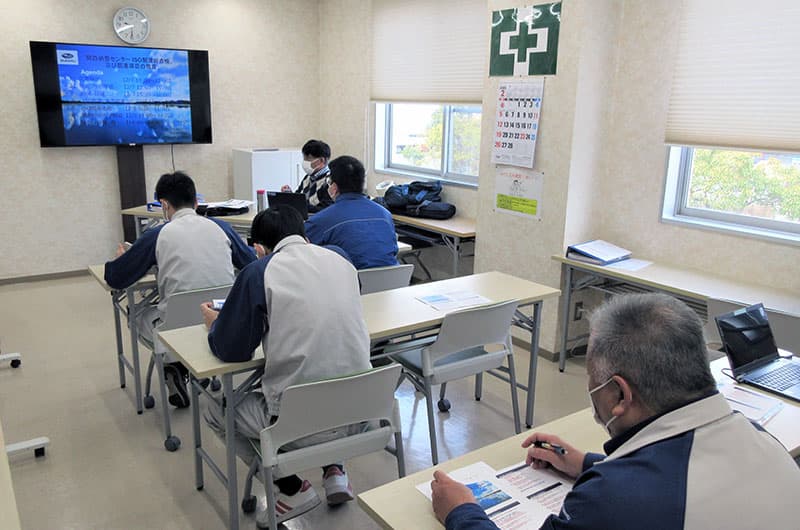
Subaru Canada, Inc.
Subaru Canada, Inc. has organized events and activities for e-Waste Week to promote awareness and education about the importance of environmental conservation, including major spring cleaning. For Clean Air Day in Canada, Subaru Canada also held a breakfast meeting and a unique commuting challenge for all employees who walk/run to work or otherwise commute by bicycle, by public transport, or by carpooling.
External Partnerships
Alliance with Toyota
SUBARU and Toyota are working together to create ever-better cars by bringing together their respective strengths in technology and expertise, with engineers from both companies engaging in mutual learning and collaboration. Following joint development by the two companies, the new Trailseeker, one of four battery electric vehicles to be added to the lineup by the end of 2026, was unveiled worldwide at the New York International Auto Show in April 2025. SUBARU will continue to accelerate its efforts toward electrification and other initiatives with the aim of helping to bring about a carbon-neutral society.
Japan Automobile Manufacturers Association, Inc. (JAMA)
SUBARU is a member of the climate change committee of Japan Automobile Manufacturers Association, Inc. (JAMA). Also, the President is a JAMA director responsible for the body’s executive decision making, and decisions made by JAMA are reflected in SUBARU’s management.
Environmental Innovation Consortium
Gunma Prefecture has set a target of zero greenhouse gas emissions by 2050 in its Gunma Five Zero Declaration, and is promoting green innovation initiatives that aim to achieve both a sustainable, self-sufficient, decentralized society and economic growth. To this end, it launched the Environmental Innovation Consortium in 2022.
SUBARU has been a member of the Consortium since its inception, participating in the Manufacturing Subcommittee. Through proposals and study sessions aimed at achieving carbon neutrality in electricity and fuel within Gunma Prefecture, SUBARU is fostering enthusiasm among local companies and working to build a supply chain.
Initiative based on the Declaration of Biodiversity by Keidanren (Japan Business Federation)
SUBARU has endorsed the Declaration of Biodiversity by Keidanren and Action Policy and participates in the Initiative based on the Declaration of Biodiversity by Keidanren, reporting our initiative policy regarding biodiversity.
Task Force on Climate-related Financial Disclosures (TCFD)
SUBARU recognizes that climate change is one of the most pressing global issues, and supports the recommendations of the TCFD. We have also joined the TCFD Consortium, which promotes joint initiatives among domestic companies, financial institutions, and others. Information on SUBARU’s disclosure of the TCFD’s recommended items is provided in our TCFD Content Index (https://www.subaru.co.jp/en/csr/tcfd/).

